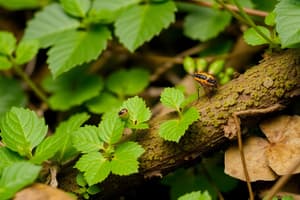Podcast
Questions and Answers
What is the primary distinction between a population and a community in ecology?
What is the primary distinction between a population and a community in ecology?
- A population accounts for the global ecosystem, while a community focuses on individual organisms.
- A population consists of multiple individuals of the same species, while a community consists of different populations. (correct)
- A population includes different species, while a community includes only one species.
- A population refers to an ecosystem, while a community refers to a biome.
Which of the following is an example of mutualism?
Which of the following is an example of mutualism?
- Bees pollinating flowers (correct)
- Barnacles attaching to whales
- Two species competing for food
- Ticks feeding on mammals
What role do primary consumers play in an ecosystem?
What role do primary consumers play in an ecosystem?
- They recycle nutrients within the soil.
- They produce energy through photosynthesis.
- They consume primary producers. (correct)
- They are the top predators of an ecosystem.
Which process describes the initial colonization of barren land by organisms?
Which process describes the initial colonization of barren land by organisms?
What is meant by the term 'niche' in ecology?
What is meant by the term 'niche' in ecology?
Study Notes
Ecology
Definition
- Ecology is the branch of biology that studies the interactions between organisms and their environment.
Levels of Organization
- Individual: Single organism.
- Population: Group of individuals of the same species in a specific area.
- Community: Different populations that live together in a defined area.
- Ecosystem: Community of living organisms interacting with their physical environment.
- Biome: Large areas characterized by specific climate and ecosystems (e.g., tundra, rainforest).
- Biosphere: The global sum of all ecosystems, where life exists.
Key Concepts
- Habitat: The natural environment where an organism lives.
- Niche: The role or function of an organism within its habitat.
- Biotic Factors: Living components of an ecosystem (e.g., plants, animals, microbes).
- Abiotic Factors: Non-living physical and chemical components (e.g., sunlight, temperature, soil).
Ecological Interactions
- Predation: One species (predator) hunts another (prey).
- Competition: Species compete for the same resources (food, habitat).
- Symbiosis: Close and long-term interactions between species.
- Mutualism: Both species benefit (e.g., bees and flowers).
- Commensalism: One species benefits, the other is unaffected (e.g., barnacles on whales).
- Parasitism: One species benefits at the expense of another (e.g., ticks on mammals).
Energy Flow and Nutrient Cycling
- Food Chains: Linear sequences showing how energy and nutrients flow from producers to consumers.
- Food Webs: Complex networks of interconnected food chains.
- Producers: Organisms (usually plants) that produce their own energy through photosynthesis.
- Consumers: Organisms that obtain energy by consuming other organisms.
- Primary Consumers: Herbivores (eat producers).
- Secondary Consumers: Carnivores (eat herbivores).
- Tertiary Consumers: Top predators (eat other carnivores).
Ecological Succession
- Primary Succession: Development of an ecosystem from barren land (e.g., after a volcanic eruption).
- Secondary Succession: Re-establishment of a disturbed ecosystem (e.g., after a fire).
- Pioneer Species: First species to colonize barren areas, helping to create soil.
Biodiversity
- Refers to the variety of life in a particular ecosystem.
- High biodiversity contributes to ecosystem resilience and stability.
- Threats to biodiversity include habitat destruction, pollution, climate change, and invasive species.
Conservation Biology
- Study of preserving biological diversity and ecosystems.
- Strategies include habitat protection, restoration ecology, and sustainable practices.
Ecology Definition
- Ecology studies how living things interact with their surroundings.
Levels of Organization
- Individual: Single organism
- Population: Same species group in a specific area
- Community: Different populations living together
- Ecosystem: Community interacting with environment
- Biome: Areas with similar climate and ecosystems, like tundras or rainforests
- Biosphere: All ecosystems globally where life exists
Key Concepts
- Habitat: Organism's natural living space
- Niche: Organism's role or function in its habitat
- Biotic Factors: Living parts of an ecosystem, like plants, animals, and microbes
- Abiotic Factors: Non-living parts of an ecosystem, like sunlight, temperature, and soil
Ecological Interactions
- Predation: One species hunts another
- Competition: Species fight for resources like food and territory
- Symbiosis: Close, long-term interactions between species
- Mutualism: Both species benefit, like bees and flowers
- Commensalism: One species benefits, the other is unaffected, like barnacles on whales
- Parasitism: One species benefits while harming the other, like ticks on mammals
Energy Flow and Nutrient Cycling
- Food Chains: Show linear energy and nutrient flow from producers to consumers
- Food Webs: Interconnected networks of food chains
- Producers: Make their own energy through photosynthesis, often plants
- Consumers: Get energy from consuming other organisms
- Primary Consumers: Herbivores that eat producers.
- Secondary Consumers: Carnivores that eat herbivores.
- Tertiary Consumers: Top predators that eat other carnivores.
Ecological Succession
- Primary Succession: Ecosystem development from barren land, like after volcanic eruptions
- Secondary Succession: Ecosystem re-establishment after disturbance, like after a fire
- Pioneer Species: The first species to colonize barren areas, helping to create soil
Biodiversity
- Variety of life in an ecosystem.
- High biodiversity means a more resilient and stable ecosystem.
- Threats include habitat destruction, pollution, climate change, and invasive species.
Conservation Biology
- Focuses on preserving biodiversity and ecosystems.
- Strategies include protecting habitats, restoring ecosystems, and promoting sustainable practices.
Studying That Suits You
Use AI to generate personalized quizzes and flashcards to suit your learning preferences.
Description
This quiz delves into the fundamentals of ecology, covering definitions, levels of organization, and key concepts. You'll explore the intricate relationships between organisms and their environments, focusing on various ecological interactions. Test your knowledge on habitats, niches, and the factors that shape ecosystems.




